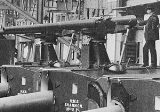
QF 12 pounder 18 cwt naval gun
Encyclopedia
The QF 12 pounder 18 cwt gun was a 3 inch high-velocity naval gun used to equip larger British warships such as battleships for defence against torpedo boats. 18 cwt referred to the weight of gun and breech (18 × 112 lb = 2,016 lb or 914 kg), to differentiate the gun from others that also fired the "12 pound" (actually 12.5 lb or 5.7 kg) shell.
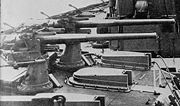
 Guns were mounted in:
Guns were mounted in:
The gun was superseded in the anti-torpedo boat role on new capital ships from 1909 onwards by the far more powerful BL 4-inch Mk VII gun
.
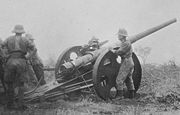 In World War I
In World War I
four guns were landed for service in the East Africa campaign
, on 10 February 1916, and were used until September. They constituted the 9th Field Battery manned by Royal Marines. They were originally towed by oxen and later by Napier lorries.
Royal Navy service


- HMS DreadnoughtHMS Dreadnought (1906)HMS Dreadnought was a battleship of the British Royal Navy that revolutionised naval power. Her entry into service in 1906 represented such a marked advance in naval technology that her name came to be associated with an entire generation of battleships, the "dreadnoughts", as well as the class of...
commissioned 1906 - The last three King Edward VII-class battleshipsKing Edward VII class battleshipThe King Edward VII class was a class of pre-dreadnought battleships launched by the Royal Navy between 1903 and 1905.-Armament:By 1901, the 29 British battleships of the Majestic, Canopus, Formidable, London, Queen, and Duncan classes then in service or under construction, all following the same...
—HMS BritanniaHMS Britannia (1904)The sixth HMS Britannia of the British Royal Navy was a pre-dreadnought battleship of the King Edward VII class. She was named after Britannia, the Latin name of Great Britain under Roman rule.-Technical characteristics:...
, HMS AfricaHMS Africa (1905)HMS Africa was a pre-dreadnought battleship of the Royal Navy. She was the penultimate ship of the King Edward VII class. Like all ships of the class , she was named after an important part of the British Empire, namely Africa....
, and HMS HiberniaHMS Hibernia (1905)HMS Hibernia was a King Edward VII-class predreadnought battleship of Britain's Royal Navy. Like all ships of the class she was named after an important part of the British Empire, namely Ireland....
, commissioned 1906–1907 - Lord Nelson-class battleshipsLord Nelson class battleshipThe Lord Nelson class was a two-ship class of pre-dreadnought battleships built by the Royal Navy between 1905 and 1908. Although they were the last British pre-dreadnoughts, both were completed and commissioned after HMS Dreadnought had entered service. and were serving in the Channel Fleet when...
commissioned 1908 - Minotaur-class armoured cruisersMinotaur class cruiser (1906)The Minotaur class was a three-ship class of armoured cruiser built around 1906 for the Royal Navy. They served during World War I, with all three being present at the Battle of Jutland, where HMS Defence was sunk. The surviving ships were scrapped postwar.-History:The Minotaur class was the last...
commissioned 1908–1909
The gun was superseded in the anti-torpedo boat role on new capital ships from 1909 onwards by the far more powerful BL 4-inch Mk VII gun
BL 4 inch naval gun Mk VII
The BL 4-inch gun Mk VII was a British high-velocity naval gun introduced in 1908 as an anti-torpedo boat gun in large ships, and in the main armament of smaller ships...
.
World War I land service

World War I
World War I , which was predominantly called the World War or the Great War from its occurrence until 1939, and the First World War or World War I thereafter, was a major war centred in Europe that began on 28 July 1914 and lasted until 11 November 1918...
four guns were landed for service in the East Africa campaign
East African Campaign (World War I)
The East African Campaign was a series of battles and guerrilla actions which started in German East Africa and ultimately affected portions of Mozambique, Northern Rhodesia, British East Africa, Uganda, and the Belgian Congo. The campaign was effectively ended in November 1917...
, on 10 February 1916, and were used until September. They constituted the 9th Field Battery manned by Royal Marines. They were originally towed by oxen and later by Napier lorries.
Ammunition
The gun fired the same 12.5 lb 3 inches (76.2 mm) shells as the other British "QF 12 pounder" guns, but used its own larger separate cartridge case to accommodate a larger quantity of cordite propellant.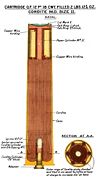 |
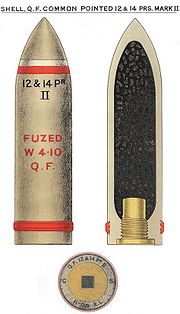 |
 |
 |
 |
Cordite Cordite is a family of smokeless propellants developed and produced in the United Kingdom from 1889 to replace gunpowder as a military propellant. Like gunpowder, cordite is classified as a low explosive because of its slow burning rates and consequently low brisance... Cartridge Mk II, 1914 |

